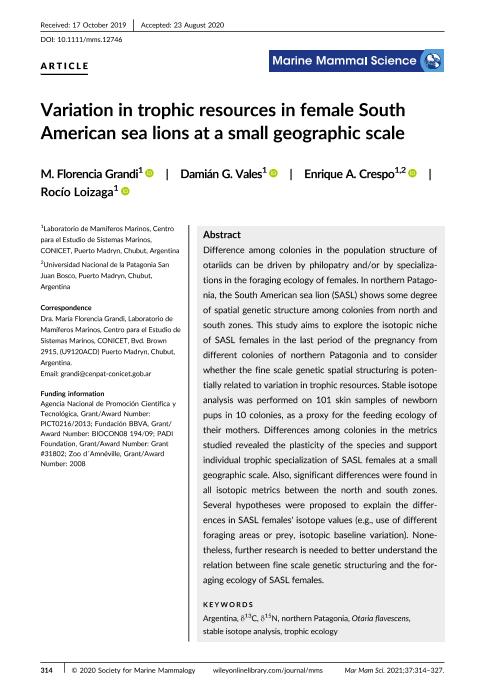Artículo
Variation in trophic resources in female South American sea lions at a small geographic scale
Fecha de publicación:
01/2021
Editorial:
John Wiley & Sons Inc
Revista:
Marine Mammal Science
ISSN:
0824-0469
e-ISSN:
1748-7692
Idioma:
Inglés
Tipo de recurso:
Artículo publicado
Clasificación temática:
Resumen
Difference among colonies in the population structure of otariids can be driven by philopatry and/or by specializations in the foraging ecology of females. In northern Patagonia, the South American sea lion (SASL) shows some degree of spatial genetic structure among colonies from north and south zones. This study aims to explore the isotopic niche of SASL females in the last period of the pregnancy from different colonies of northern Patagonia and to consider whether the fine scale genetic spatial structuring is potentially related to variation in trophic resources. Stable isotope analysis was performed on 101 skin samples of newborn pups in 10 colonies, as a proxy for the feeding ecology of their mothers. Differences among colonies in the metrics studied revealed the plasticity of the species and support individual trophic specialization of SASL females at a small geographic scale. Also, significant differences were found in all isotopic metrics between the north and south zones. Several hypotheses were proposed to explain the differences in SASL females' isotope values (e.g., use of different foraging areas or prey, isotopic baseline variation). Nonetheless, further research is needed to better understand the relation between fine scale genetic structuring and the foraging ecology of SASL females.
Archivos asociados
Licencia
Identificadores
Colecciones
Articulos(CESIMAR)
Articulos de CENTRO PARA EL ESTUDIO DE SISTEMAS MARINOS
Articulos de CENTRO PARA EL ESTUDIO DE SISTEMAS MARINOS
Citación
Grandi, Maria Florencia; Vales, Damián Gustavo; Crespo, Enrique Alberto; Loizaga, Rocío; Variation in trophic resources in female South American sea lions at a small geographic scale; John Wiley & Sons Inc; Marine Mammal Science; 37; 1; 1-2021; 314-327
Compartir
Altmétricas




